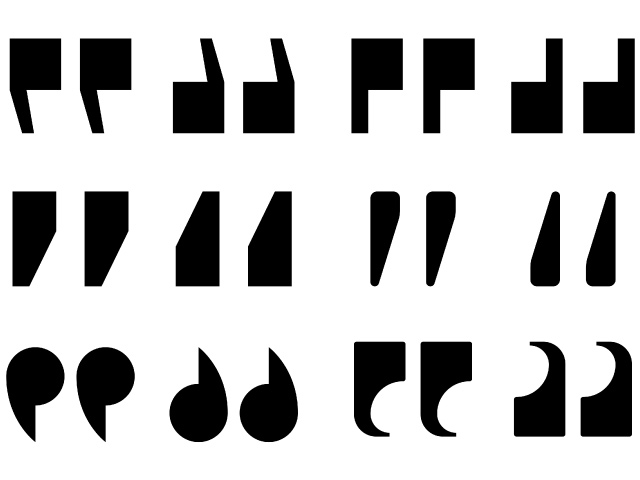What are quotation marks?
Quotation marks are fundamental punctuation marks in written English. It is essential to use them well so that communication is clear.
Rules of quotation marks
In written English, quotation marks are used to indicate direct speech, quotations, titles, and other linguistic nuances.
They are so used to draw attention to words or language elements in your text. They make it possible to reproduce exactly what an author says.
Here are the main uses of quotation marks :
· Distinguish words and extracts quoted from the rest of the text.
· Directly quoting a source, showing the changement of speaker in a dialogue or to separate dialogue and speaker, pointing out titles of short words, doubting the validity of a word, or differentiating a nickname.
Quotes can be used at the beginning or end of a sentence, in the middle of a sentence or in a broken quote.
Examples of use of quotations marks
1. Before or after a direct quote
· “Didn’t you forget your doctor’s appointment?” asked his mother.
· The words of a person’s speech are written exactly as they were spoken.
NOTE :
In dialogue, quotation marks are used to identify words someone says. You’ll often find them in fiction with the words spoken by the characters for example. In newspaper, journalists use quotation marks to design a direct quote from a person in the article. In academic articles, quotation marks are used when you are mentioning a paper writting by someone else.
2. To separate a direct quote from the rest of the sentence with a coma, an exclamation point or a question mark
· “What a beautiful garden!” exclaimed my neigbor.
· The teacher asked : “ Where were you? ”
NOTE :
Make sure the question mark and exlamation mark are part of the quotation before enclosing them in quotation marks. Otherwise place them outside the closing quotation marks.
=> American English vs. British English :
There is a difference between American and British English where punctuation marks go when used with quotation marks. In American English, the punctuation marks are always placed inside the quotation mark. British English places the punctuation outside the quotation except if it is part of the quote. Question marks and exclamation points that are part of the quote go inside the quotation marks in British and in American English.
American English: “The extra-terrestrials appeared over the Earth.”
British English: ‘The extra-terrestrial appeared over the Earth’.
3. Title of works
Quotation marks are commonly used to enclose the titles of shorter works such as articles, short stories, songs, poems, …
· I recently read “Technofeudalism” by Yanis Varoufakis.
· Have you seen the movie “Prisoners”?
4. To refer to a word
· She cooks very well! She’s the “Queen” of the kitchen.
The quotation marks in this example show that you are talking about the word itself and that is not a direct quote from someone.
5. To differentiate a nickname from a first name
If you write a person’s nickname next to the first name, separate it with quotation marks so the reader knows it is not part of the legal name.
· Elvis “ The King” was an exceptional singer.
NOTE :
The nickname should generally be placed in quotation marks between the first and last name.
Quotation marks are not necessary if the nickname is the most common way to name a famous person. It is the case for many historical figures such as Richard the Lionheart for example.
6. Several quotes
In British English, when a citation appaears within another citation, double quotes are used for the inner quote and single quotes are used for the outer quote.
· British English : She said, ‘He told me, “I’ll be there next Saturday.”’
· American English : She said “He told me, ‘I’ll be there next Saturday.’”
NOTE :
=> American English vs. British English :
The use of the English language is different between American and British English. This also true with the quotation marks.
Both American and British English use differently single and double quotation marks.
So to avoid mistakes when using quotation marks, first decide on the language style to write.
In American English, single quotes are used for the inner quote and double quotes are used for the outer quote.
7. To indicate irony
The quotation marks can indicate that a word is used ironically or figuratively.
· He is considered “a mastermind” by his friends.
In summary
Quotation marks have an essential role in typography and in grammar. They always work in pairs: the opening quotation mark and the closing quotation mark. They are used to transcribe the exact words of a quoted extract, to highlight specific words or sentences or to indicate irony.
However, each language uses different styles of quotation marks: single or double angle brackets, straight or curly shapes, with varying positions and orientations.
«…» : French quotation marks,
»…« : German quotation marks,
“ ... ” : English/American quotation marks,
'...' : Single quotation marks.
Conclusion
In conclusion, the correct use of quotation marks is essential for effective written communication in English.
By understanding when and how to use single and double quotation marks, respecting the correct place of punctuation, and grammatical rules, you can be sure of clarity and precision in your writing.
Sources.
· Quotation marks: when and how to use them to quote accurately?, (2024). https://www.compilatio.net/en/blog/quotation-marks
· Quotation marks and direct quotations, (1997). https://www.sussex.ac.uk/informatics/punctuation/quotes/marks










